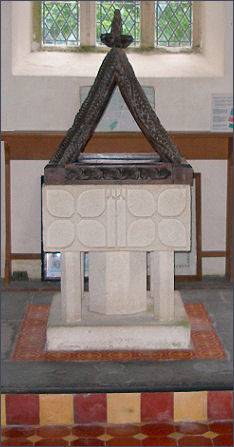Ruan Lanihorne
OS grid reference :-SW 887 419
 The historic hamlet of Ruan Lanihorn is situated approximately four miles (6.5 km) to the east-southeast of Truro. It lies in a wooded area between the River Fal and its tributary the Ruan River and straddles what was once the old coach road from Penzance to London on the Roseland Peninsula.
The historic hamlet of Ruan Lanihorn is situated approximately four miles (6.5 km) to the east-southeast of Truro. It lies in a wooded area between the River Fal and its tributary the Ruan River and straddles what was once the old coach road from Penzance to London on the Roseland Peninsula.
The name Lanihorne is a modified form of the Cornish name Laryhorn. The village was, from the mid twelfth century onwards, the site of a castle of the local Lercedekne family.John Lercedekne was granted permission to build the castle to guard the river crossing by King Edward III in 1334. The castle appears to have comprised of a round keep, known locally as the 'round tower', it was described as having a 40 feet high keep, seven or eight towers and possibly an outer court. The Tudor antiquary Leland described it "as a castelle of an eight towers, then decaying for lak of coverture." The castle was demolished in the nineteenth century.
In the nineteenth century, silt was unloaded to make bricks at Trelonk. The village pub, the King's Head, situated in the centre of the village, has roaring fires, beamed ceilings and a friendly ambience. It serves food with as much fresh local produce as possible.
The delightful Reading Room, situated by Ruan Creek, was once a Carpenter's workshop which had a room where the newspapers were placed and could be read. This room, together with other parts of this building were purchased and given to the parish, the name Reading Room continued in use. It has been used for film shows, other forms of entertainment.
The creek at Ruan Lanihorne is popular with bird watchers as it provides a haven for waders and waterfowl, while the gentle hills and leafy lanes provide some spectacular walking and cycling trails. Situated at Ruan High Lanes, Poppy Cottage Garden is an enchanting 1 acre cottage garden which is a gardener's paradise.
The Church of St. Rumon
OS grid reference SW 894 420

 The granite village church was dedicated to St Rumonus (or Rumon) in 1321.
The granite village church was dedicated to St Rumonus (or Rumon) in 1321.
This saint is also honoured at Tavistock Abbey and at Grade-Ruan in Cornwall. Tradition states that Ruan Lanihorne was the centre of his cult until his bones were removed to Tavistock Abbey sometime in the tenth century.
The church comprises a chancel, nave, north aisle, and south transept. The arcade has six four-centred arches of porcelain stone. The earliest recorded rector of the church was Sir William de Bodrygan in 1282, although a church probably occupied the site prior to this.
In around 1658 a violent storm caused the collapse of the church's tower which caused major damage to the nave and south transept. A local Gentleman Farmer, Richard Trestain, met the cost of rebuilding the transept. On his death, a few years later in 1664, he was buried in the corner of the transept in a tomb covered with a carved stone showing a medieval monk.
The unusual font dates to the fourteenth century, its cover and the altar are made from fragments of roof carving and bosses. A small fragment of rood screen of St Ewe type with carved figures, survives. The pulpit is made from sixteenth century bench-ends with symbols of the Passion.
Restoration work on the building included the installation of a stained glass window in 1866.
The leading family in the area were the Archdeacons or Lercedeknes, whose castle once dominated the river and who were patrons of the church. A thirteenth-century tomb in the south transept may commemorate a priestly member of the Lercedeknes family or perhaps St Rumon himself.
 The earliest connection between Lercedekne family and Lanihorne is in the Inquisition recorded at the death of Thomas Lercedekne in 1303 which lists the Manor of Lanihorne as one of his holdings. The family held the Castle for a number of generations and gave service to the King in the wars against the Scots. Thomas Lercedekne, the son of the above Thomas was slain at the Battle of Bannockburn. The male line of the family became extinct at the death of Sir Warin Lercedekne in 1400.
The earliest connection between Lercedekne family and Lanihorne is in the Inquisition recorded at the death of Thomas Lercedekne in 1303 which lists the Manor of Lanihorne as one of his holdings. The family held the Castle for a number of generations and gave service to the King in the wars against the Scots. Thomas Lercedekne, the son of the above Thomas was slain at the Battle of Bannockburn. The male line of the family became extinct at the death of Sir Warin Lercedekne in 1400.
The Ten Commandments, Creed and Lord's Prayer, are painted on board, and probably date from the early nineteenth-century. The Victorian shields depict the arms of Oxford and Cambridge colleges.
The stitch work map of the parish was created in the 1990s using embroidery, crochet and knitting.
In the churchyard stands an interesting sundial dated 1743 which bears the names of 2 of the churchwardens.
Opposite the the churchyard in a nearby field are the remains of St Rumon's Well which is believed to be of ancient origin, the present structure may possibly be medieval. It is emi-circular with a stone arch entrance to a half dome vault.
The Rev John Whitaker, author of The Cathedral of Cornwall and other historical works, was Rector of Ruan Lanihorne for thirty years (1778-1808)